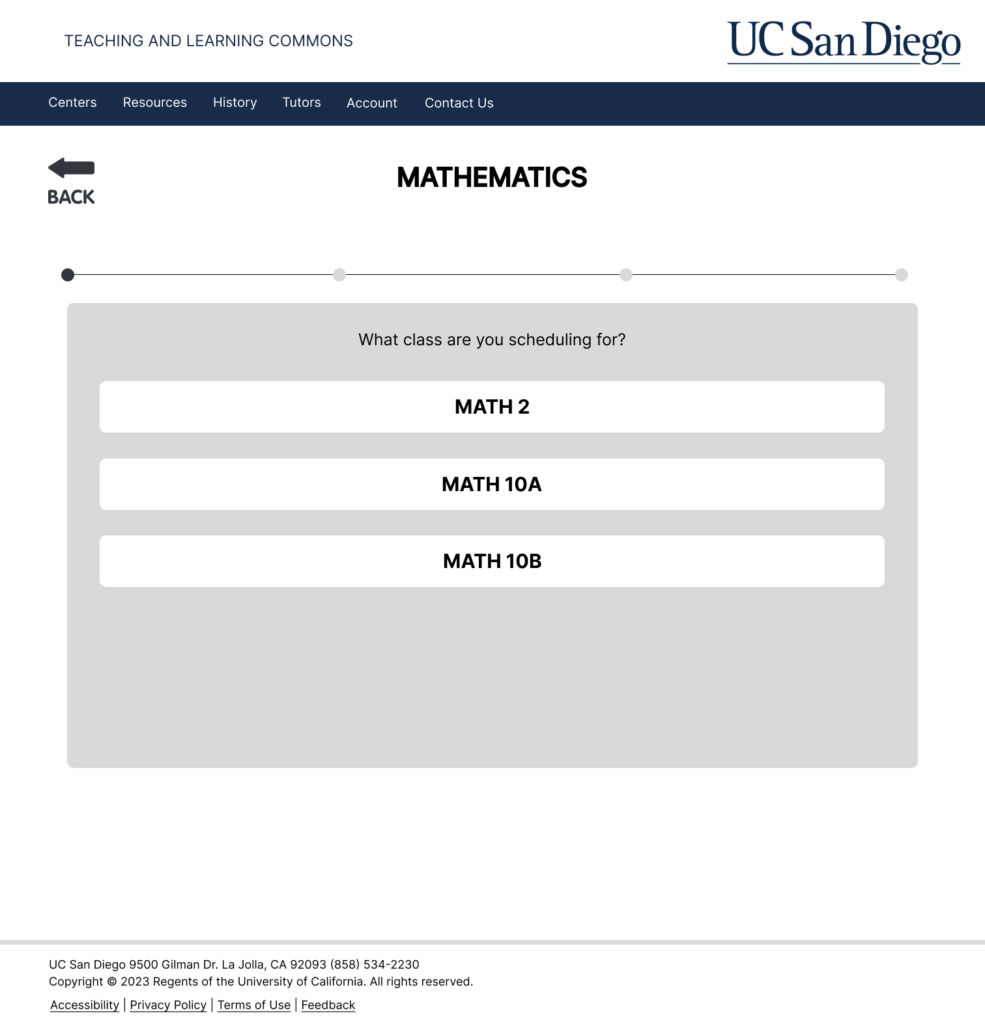REDROCK CONTENT TUTORING SCHEDULING REDESIGN
UC San Diego Association of Computing Machinery

Project Overview:
Role: Lead UX and Product Designer
Team: Ashley Nguyen, Ellen Chang, Joanne Tsai
Skills: User Interviews, User Research, UI Design, Prototyping
Timeline: September 2023 – January 2024
At UC San Diego, the Association of Computing Machinery (ACM) has created an opportunity for students to create and design efficient mobile application per quarter. With our website, we intend to create a more accesible application that allows users to access information regarding content tutoring and schedule tutoring appointments at Geisel Library’s Teaching and Learning Commons.
PROBLEM:
How might we promote the tutoring services and improve user experiences with creating online appointments on Redrock?
What is RedRock?
RedRock is a platform or website associated with content tutoring services for UC San Diego undergraduate students. The platform appears to facilitate the scheduling of tutoring appointments for services related to course-specific learning skills and strategies.
Why redesign RedRock:
- Visual appeal
- Lack of comprehensive information
- No search functionality
- Need for streamlined navigation
- Compact interface
My Contributions
During the RedRock redesign initiative for the Geisel Library’s Teaching and Learning Commons tutoring scheduling webpage, I played a central role as the lead designer. My contributions began in the research phase, where I directed our efforts in conducting interviews, surveys, and usability tests. This work was crucial in uncovering user preferences and identifying common challenges faced by students and tutors alike. The insights gained from this research were instrumental in guiding the project’s direction, ensuring that the redesign met the actual needs of its users.
My involvement extended beyond research; I took the helm in the prototyping and wireframing stages of the design process. Leveraging my deep understanding of UX/UI design principles, I led the development of prototypes and wireframes that laid the foundation for our redesigned interface. These efforts were geared towards creating intuitive user flows and visually engaging interfaces that would significantly improve the usability and visual appeal of the RedRock scheduling webpage.
USER RESEARCH
Our research findings, derived from interviews with undergraduate students at UC San Diego through Google Forms and task-based interviews, uncovered several areas for improvement in the teaching and learning commons tutoring scheduling website:
- Users struggled with menu options, search functionality, and overall portal navigation, indicating a need for a more intuitive layout and improved navigational aids.
- Difficulties were noted in scheduling, canceling, and rescheduling appointments, highlighting the necessity for a more streamlined and user-friendly appointment management system.
- Criticisms included small buttons, unclear affordances, and an outdated visual design in the user interface, suggesting that modernizing the design and focusing on clearer, more accessible elements are essential.
- The search for availability feature was found to be confusing or challenging for users, pointing towards the importance of enhancing the clarity and functionality of the search tool.
- Some users faced challenges in confirming or canceling appointments, underscoring the need to ensure reliability and ease in the appointment management process.
8/10 users had never heard of the Teaching and Learning Commons
10/10 users took classes that had tutoring offered for them
6/10 users took expressed confusion with the poor navigation when viewing the website
Competitive Analysis



DESIGN PROCESS
Low Fidelity Prototypes


High Fidelity Prototypes



Solutions and Functions


Final Prototype
Review and Reflection
The review of the portfolio’s last portion highlights several key areas for improvement. Firstly, it suggests conducting more in-depth interviews with individuals familiar with the Teaching and Learning Commons to gather comprehensive data. This would involve refining interview questions to elicit more thorough responses and insights. Additionally, the review emphasizes the importance of conducting further research and analysis on other tutoring websites to gain a broader understanding of industry practices and trends.
In reflection, it’s evident that there were challenges encountered throughout the project. Difficulty in coordinating meeting times within the group and limited access to data due to the Teaching and Learning Commons’ low visibility posed significant obstacles. Furthermore, certain constraints, such as the limited availability of classes and the system’s restriction on appointment scheduling, imposed additional limitations on the project’s scope and effectiveness. Moving forward, addressing these challenges and constraints will be crucial in refining the portfolio’s content and achieving its objectives more effectively.
Looking Forward
Looking towards the future, my team and I are committed to implementing several strategies to enhance the portfolio and improve the overall user experience. Firstly, we plan to dedicate specific portions of the website to different programs offered by the Teaching and Learning Commons, providing users with clear and comprehensive information tailored to their needs. Additionally, we aim to develop a robust tutor biography section, offering detailed profiles that highlight each tutor’s qualifications, expertise, and availability. Furthermore, we intend to revamp the scheduling system to provide greater flexibility and convenience for users, allowing for appointments to be made further in advance and streamlining the booking process. By focusing on these initiatives, we aim to elevate the portfolio’s functionality and usability, ultimately better serving the needs of our audience and maximizing the impact of the Teaching and Learning Commons.
